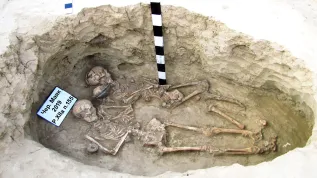
In the 5th century, the fundamental demographic processes shaping the genetic structure of the 10th-12th century population living in the area of contemporary Poland had ended. No additional migration after the 5th century in Central Europe (CE) was necessary for the formation of the genetic structure of the inhabitants of the Piast State, shows the research of scientists led by Professor Marek Figlerowicz.
According to the researchers, the recent paper 'Genetic history of East-Central Europe in the first millennium CE' published in Genome Biology is 'a turning point in over 200 years of heated discussion on the most fundamental issues related to the origin of the Western Slavs, including the society of the Piast State'.
The authors of the groundbreaking article for the understanding of the history of Central and Eastern Europe, are biologists, archaeologists and historians working in an interdisciplinary research team led by Professor Marek Figlerowicz, as part of the project 'Dynasty and population of the Piast state in view of integrated historical, anthropological and genomic studies'. The scientists involved in the project are affiliated with the Institute of Bioorganic Chemistry of the Polish Academy of Sciences in Poznań, as well as the faculties of Biology and History of the Adam Mickiewicz University.
Professor Figlerowicz told a recent press conference that when it comes to the appearance and presence of the Slavs in Central Europe, there are two extreme hypotheses. 'For 200 years, there has been a very heated discussion about whether the prevailing theory is the indigenous or allochthonous hypothesis. The indigenous hypothesis assumes that the Slavs had always lived here, while the allochthonous hypothesis assumes that the Germans had lived here, and after the period of great migrations they left our lands, and the Slavs replaced them,’ he said.
The team publishing in Genome Biology showed that 'both of these hypotheses were false.’
'It is not true that the Slavs had lived here; in fact, it was people who were very similar to generally all other neighbours living on the southern coast of the Baltic Sea, the lands of today's Poland were inhabited by people who were similar to people from northern Germany, similar to those who lived in Denmark at that time, that is, 2,000 years ago, similar to Lithuania, Latvia - that is, those people also of that time,’ Figlerowicz says.
He called the new findings a 'breakthrough in research'.
The professor said that the research showed that 'in the area of modern Poland, more or less in the first centuries, there was probably a small migration from the north, which introduced even more of this northern component to our lands.’
He added that the newcomers wandered through Poland more or less from the vicinity of Gdańsk, along the Vistula, and then the Bug River, to the south-eastern border of present-day Poland near Masłomęcz, mixing with the local populations.
He continued: ‘When we examine the population that made up this Masłomęcz group, that is, the group of migrants from the north mixing with the local populations, it turns out that this is more or less the same population as the one that formed the Piast State.’
He pointed out that 'while we were able to study immigrants from the north - because they (...) did not cremate, they buried their dead, for the local population, cremation was the main funeral rite all the time, so it was not possible to find any data that would describe this local population.
'And what we managed to do was that we watched migrants who passed through Poland and mixed with the local population. And these admixtures showed us who the local people were. It turned out that this population was generally similar to those that lived along the entire southern coast of the Baltic. And the mixture was all that was needed to create the society of the Piast state. This shows that all the creations that people invented - Goths, Slavs, etc. - are just concepts, they do not have much to do with the genetics and biological history of these peoples.’
During the conference, the researchers emphasized that the collapse of the Western Roman Empire under the pressure of barbarian tribes led to the emergence of completely new political and ethnic structures in Europe.
'While the historical events and processes underlying the transformation from antiquity to Christianity in the territories of the Empire are relatively well known, we still know little about the transformations that took place simultaneously in territories not belonging to the newly formed Christian community. One such event that still raises numerous controversies is the appearance of the Slavs in Central Europe. In order to explain it, two opposing hypotheses were formulated many years ago. The first, allochthonous hypothesis, states that the Slavs came to this region of Europe not earlier than in the 6th century CE, while according to the second, autochthonous hypothesis, the Slavs had inhabited the area between the Oder and the Vistula long before the Migration Period, traditionally dated between 375 CE (the invasion of Europe by the Huns) and 568 CE (the conquest of Italy by the Lombards),’ the researchers say.
The data collected so far indicate that at the end of the Late Neolithic period, 3700-1800 BCE, the genetic structures of populations inhabiting Central Europe stabilized and remained largely unchanged until the end of the Bronze Age, 1800-700 BCE. During that period, three main genetic components formed the genomes of the inhabitants of Central Europe. The first component was related to Mesolithic western hunter-gatherers who arrived in Europe about 14,000 years ago. The second - with Neolithic Anatolian farmers who migrated to Europe 7-8,000 years ago. The third - with shepherds from the Caspian and Black Seas, who spread across Europe 4-5,000 years ago.
Professor Marek Figlerowicz explained during the conference that 'the issues related to the later development of the genetic history of Central and Eastern Europe remained an open question for years, mainly due to the lack of appropriate material for archaeogenomic research. Cremation of the dead was a common funeral rite in this region from the Bronze Age to the Middle Ages.
'To solve this problem we used the fact that in the first centuries in what is now Poland, inhumation (burial of corpses) became the dominant burial practice among the population associated with the Wielbark culture. This population existed in the Vistula basin between the 1st and 5th centuries CE. Most theories connect its origin with the migration of northern peoples commonly known as Goths.’
He added that archaeological research so far indicates that by the 5th century in Central Europe, immigrants from the north lived next to the cremation-practicing local populations associated with the earlier Przeworsk culture. The final stage of the coexistence of the Wielbark and Przeworsk cultures in the territory of present-day Poland coincided with the Migration Period. After its end, the material cultures in this area became more homogeneous, and archaeologists commonly identify them as the Slavs, who continued to practice cremation of the dead until the baptism of the first Polish ruling dynasty (in 966 CE).
Taking these facts into account, the scientists from Poznań decided to focus their multidirectional archaeogenomic research on two populations that inhabited the area of modern-day Poland in the past. The first population consisted of representatives of the Wielbark culture. The second population consisted of representatives of the society of the Piast State.
The research covered 474 people buried in 27 cemeteries. Whole genome data were obtained for 197 of them.
'The analyses showed that the populations associated with the Wielbark culture were mainly men migrating from the north and local women. In addition, in the genomes of people who were a mixture of newcomers from the north and the local population, we found practically all genetic components present in the genomes of the population forming the society of the Piast State. This means that already in the 5th century CE, the fundamental demographic processes shaping the genetic structure of the 10th-12th century population living in the area of contemporary Poland CE had ended. In other words, the results of our research indicate that no additional migration after the 5th century CE was necessary for the formation of the genetic structure of the inhabitants of the Piast State. The presented results are therefore consistent with the hypothesis assuming genetic continuation in the first millennium CE in Central and Eastern Europe,’ the scientists from the Institute of Bioorganic Chemistry of the Polish Academy of Sciences in Poznań said. (PAP)
PAP - Science in Poland, Anna Jowsa
ajw/ agt/ zan/ kap/
tr. RL













